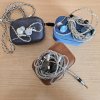Soandso
Senior Member
- Joined
- May 30, 2022
- Messages
- 412
- Likes
- 1,120
ARRT T10 planar iem is inexpensive; I got one for $55 after another ASR member briefly mentioned them. Once I got beyond trying to finesse ear tips (have Dunu S&S tips on now) and trialed them with everything from North African drums, mandolin, xylophone, jazz and classic rock they satisfied me for my significant age related hearing loss as a planar iem for casual listening without EQ. Up to now my go-to iem is an etymotic (also an ASR informed decision) and initially I tried to similarly very deep insert the ARRT T10 but that didn’t work out (my 2 ear canals vary); 2 of the attached pictures are to show the moderately elongated nozzle angles. They are marked left and right for cables worn up and over the ear.
The ARRT T10 specifies it is a ‘dual-magnetic’ planar of 14.2mm and my impression is they mean the magnets are arrayed directly opposite each other across the diaphragm. An attached photo shows 2 common planar arrays, where one (labeled A) is staggered opposing magnets - not all planar iem marketed mention the magnetic array. We can see more magnets are required for opposing arrays and it also makes the magnetic fields more cohesive. My impression of ARRTI T10 is the notes are heard crisply even when multiple instruments are involved and localization of their staging comes across. I have full size modded planar headphones that are EQ-ed for my hearing loss I use at home for critical listening and these planar iem are for when out and about - when tested I was able to fall asleep on my back with the T10s in.
It’s 1kHz rating is 16.5 ohms with maximum 1.5% distortion, sensitivity is 96dB/mw and I already have a portable amplifier (another ASR pick) to use with it, although my cell phone can drive them. The body is a plastic polymer which makes them extremely light while they nest against your ear contours. I wore them on a long walk and they did not displace at all from where I put them with Dunu S&S ear tips on. There is a single tiny through hole in the body and another very short horizontal notch along one side, neither shown in the pictures - the exact purposes of which I refrain from speculating about. There Is a screen inside the nozzle, the nozzle has a lip and it’s bore aperture is average.




The ARRT T10 specifies it is a ‘dual-magnetic’ planar of 14.2mm and my impression is they mean the magnets are arrayed directly opposite each other across the diaphragm. An attached photo shows 2 common planar arrays, where one (labeled A) is staggered opposing magnets - not all planar iem marketed mention the magnetic array. We can see more magnets are required for opposing arrays and it also makes the magnetic fields more cohesive. My impression of ARRTI T10 is the notes are heard crisply even when multiple instruments are involved and localization of their staging comes across. I have full size modded planar headphones that are EQ-ed for my hearing loss I use at home for critical listening and these planar iem are for when out and about - when tested I was able to fall asleep on my back with the T10s in.
It’s 1kHz rating is 16.5 ohms with maximum 1.5% distortion, sensitivity is 96dB/mw and I already have a portable amplifier (another ASR pick) to use with it, although my cell phone can drive them. The body is a plastic polymer which makes them extremely light while they nest against your ear contours. I wore them on a long walk and they did not displace at all from where I put them with Dunu S&S ear tips on. There is a single tiny through hole in the body and another very short horizontal notch along one side, neither shown in the pictures - the exact purposes of which I refrain from speculating about. There Is a screen inside the nozzle, the nozzle has a lip and it’s bore aperture is average.


